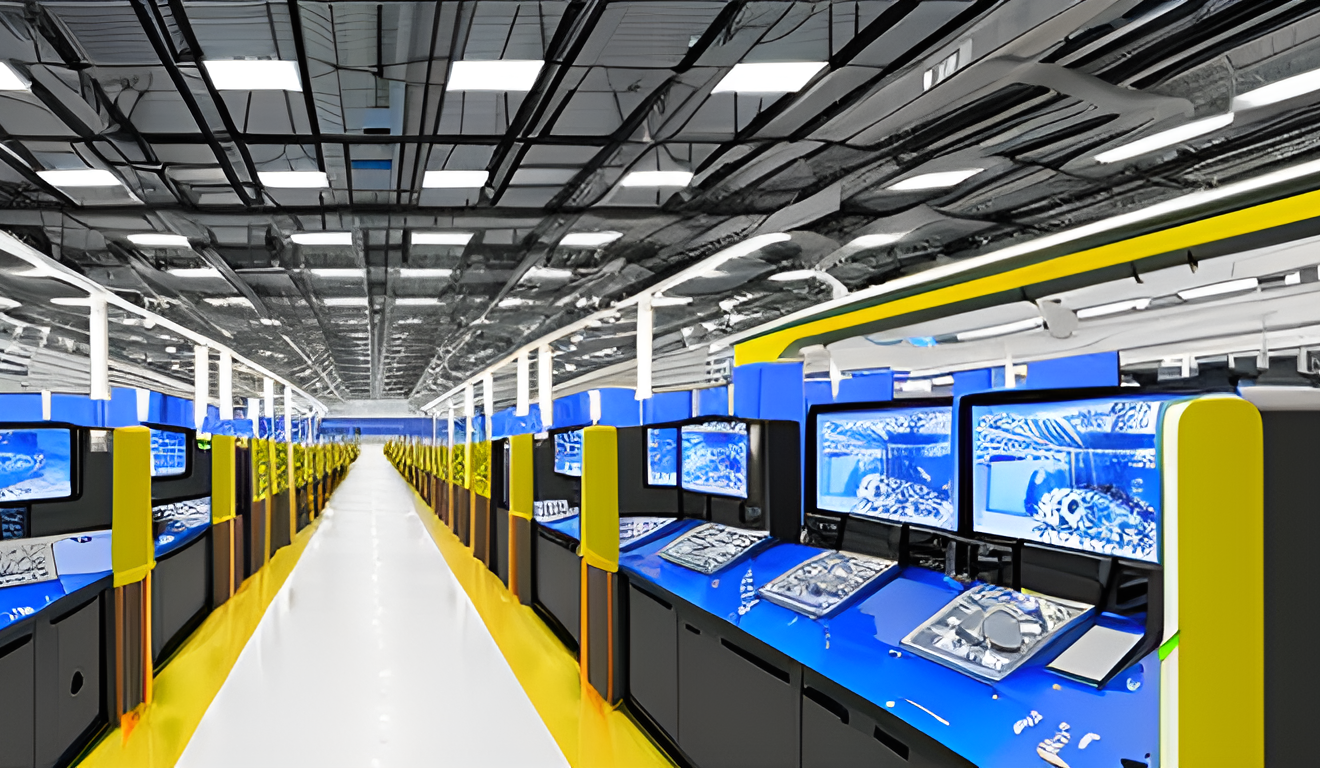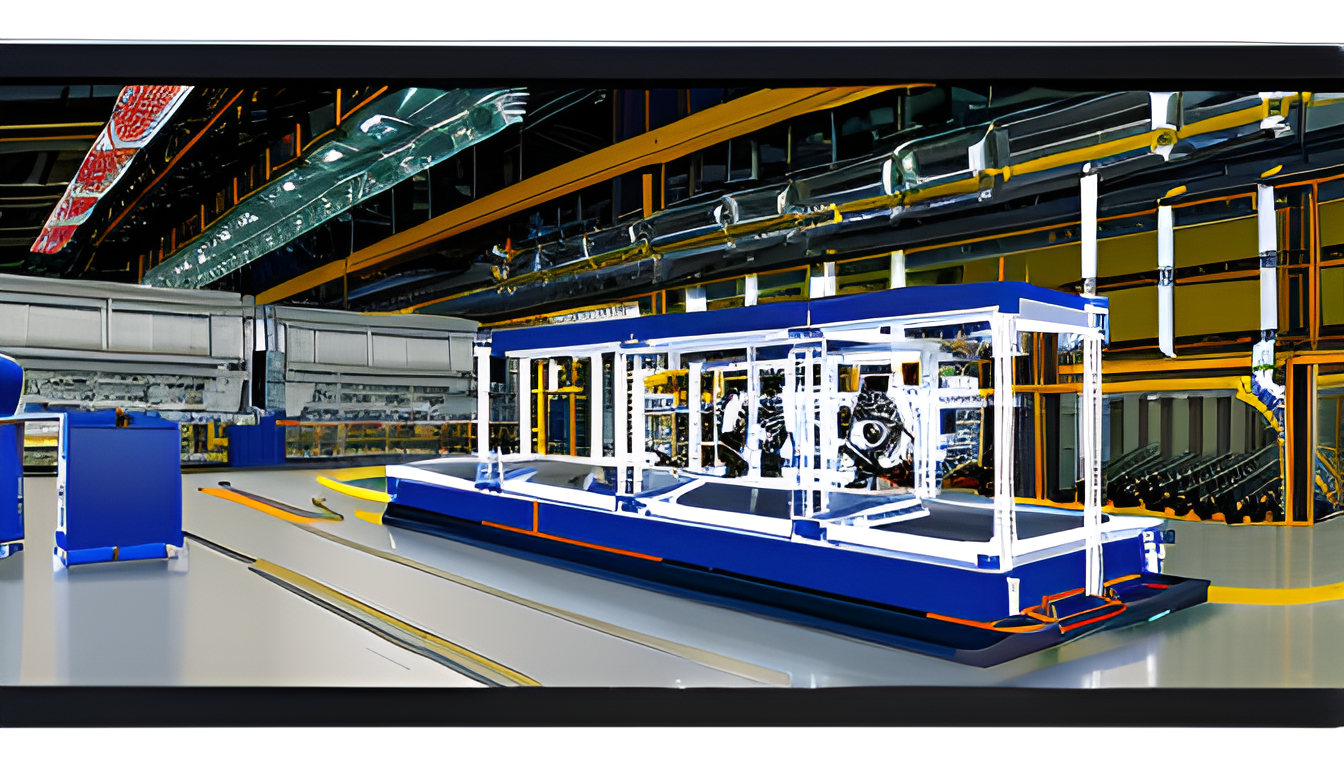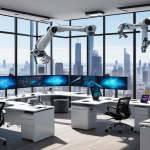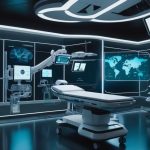Industry 4.0 and the Role of Artificial Intelligence

The dawn of Industry 4.0 is not just a new chapter in the industrial narrative; it’s a whole new book! Imagine a world where machines talk to each other, where data flows seamlessly, and where decision-making is as quick as a snap of your fingers. This is the reality we are stepping into, and at the heart of this revolution lies Artificial Intelligence (AI). AI is not merely a tool; it’s the engine driving efficiency, productivity, and innovation across various sectors.
So, what exactly does AI bring to the table in this new industrial era? Think of it as the brain behind the brawn. While machines can do the heavy lifting, AI enhances their capabilities, allowing them to learn, adapt, and optimize processes in real-time. For instance, in a manufacturing setting, AI can analyze data from various sources, predict outcomes, and help managers make informed decisions faster than ever before. This is akin to having a seasoned expert on your team, one who never sleeps and is always analyzing data to ensure peak performance.
The integration of AI into Industry 4.0 is not just about making things faster; it’s about making them smarter. With AI, industries can leverage big data to extract actionable insights, automate processes, and even enhance customer experiences. Picture a factory where machines can predict when they will need maintenance, significantly reducing downtime and saving costs. This proactive approach not only boosts productivity but also enhances the overall quality of products.
However, as we embrace these advancements, it’s crucial to recognize that the journey is not without its challenges. Issues like data security and the need for a skilled workforce are significant hurdles that industries must navigate. Just as a ship needs a skilled captain to sail smoothly through rough waters, industries need well-trained personnel to harness the full potential of AI.
In conclusion, the role of AI in Industry 4.0 is transformative, acting as a catalyst for change that enhances every facet of industrial operations. As we move forward, the synergy between AI and Industry 4.0 will undoubtedly shape the future of manufacturing and beyond, paving the way for unprecedented opportunities.
The Evolution of Industry 4.0
The journey to Industry 4.0 is like a thrilling roller coaster ride, taking us through various phases of industrial revolutions that have fundamentally changed how we produce and consume. To appreciate the significance of this new era, we must first understand the technological leaps that paved the way. From the steam engine of the first industrial revolution to the introduction of mass production techniques in the second, and the rise of automation and electronics in the third, each phase laid the groundwork for the current transformation.
As we transitioned into the fourth industrial revolution, we witnessed a remarkable convergence of technologies. This phase is characterized by the integration of cyber-physical systems, the Internet of Things (IoT), and cloud computing. These technologies don’t just operate in isolation; they work together to create a seamless flow of information and processes. Imagine a factory where machines communicate with each other, sharing data in real time to optimize production efficiency. This is the essence of Industry 4.0.
Key milestones in this evolution include:
- Introduction of IoT: Connecting devices to the internet has enabled unprecedented data collection and analysis.
- Advancements in AI: Artificial intelligence has evolved to process this data, providing actionable insights that drive decision-making.
- Big Data Analytics: The ability to analyze massive datasets has transformed how businesses understand their operations and market trends.
Moreover, the shift towards a more interconnected world has opened doors to new business models and opportunities. Companies are no longer just manufacturers; they are becoming data-driven organizations that prioritize innovation and customer-centricity. The evolution of Industry 4.0 is not just a technological shift; it’s a cultural one, demanding adaptability and forward-thinking from all sectors.
In conclusion, the evolution of Industry 4.0 represents a significant leap forward in how industries operate. By embracing these technological advancements, businesses can enhance their efficiency, productivity, and ultimately, their competitive edge in the global market.
Key Technologies Driving Industry 4.0
The landscape of Industry 4.0 is being reshaped by a myriad of cutting-edge technologies that work in tandem to create a more efficient and innovative industrial environment. At the heart of this transformation lies the integration of Artificial Intelligence (AI) with several key technologies, including the Internet of Things (IoT), big data, and cloud computing. Together, these advancements not only streamline production processes but also pave the way for smarter decision-making.
One of the most significant contributors to this revolution is the Internet of Things (IoT). By connecting various devices and systems, IoT facilitates real-time data exchange, allowing businesses to monitor operations closely. This connectivity is crucial because it enables AI to analyze data on the fly, leading to enhanced operational efficiency and improved decision-making capabilities. For instance, sensors installed on machinery can relay performance data directly to AI algorithms, which can then suggest optimizations or alert operators to potential issues.
Smart sensors are the backbone of IoT, gathering and transmitting data that provides valuable insights into operational efficiency. These devices not only collect data but also integrate seamlessly with AI systems to enable predictive maintenance. This means that instead of waiting for a machine to break down, businesses can anticipate failures and address them proactively, saving both time and money.
Moreover, the sheer volume of data generated by IoT devices can be overwhelming. This is where data analytics comes into play. By leveraging AI, industries can process and analyze vast datasets to extract actionable insights. This capability allows businesses to make informed decisions, optimize workflows, and identify trends that were previously hidden in the noise of data.
In summary, the integration of AI with IoT, big data, and cloud computing is not just a trend; it’s a fundamental shift that is driving the future of manufacturing and industry as a whole. As these technologies continue to evolve, we can expect even greater innovations that will redefine efficiency and productivity across various sectors.
Internet of Things (IoT)
The is revolutionizing the way industries operate by connecting devices and systems in a seamless network. Imagine a world where your coffee machine talks to your alarm clock to ensure your morning brew is ready just as you wake up. This is the essence of IoT—creating a web of interconnected devices that share data in real-time, enhancing efficiency and decision-making.
In the industrial landscape, IoT plays a critical role by enabling companies to monitor their operations continuously. With smart sensors and devices collecting data at every stage of production, businesses gain invaluable insights into their processes. For instance, a manufacturing plant can track equipment performance and detect anomalies before they lead to costly breakdowns. This proactive approach not only saves time but also significantly reduces operational costs.
Furthermore, the integration of AI with IoT amplifies the benefits. As data flows from various connected devices, AI algorithms analyze this information, uncovering patterns and trends that humans might overlook. This synergy allows for enhanced predictive analytics, leading to better resource allocation and more informed decision-making. For example, a factory that implements AI-driven IoT solutions can optimize its supply chain by predicting demand fluctuations based on real-time data.
Here’s a quick look at how IoT transforms industrial operations:
- Real-time Monitoring: Continuous oversight of equipment and processes.
- Predictive Maintenance: Anticipating equipment failures before they happen.
- Optimization of Resources: Efficient use of materials and energy.
In conclusion, the Internet of Things is not just a buzzword; it’s a game-changer for industries aiming to thrive in the age of Industry 4.0. By leveraging IoT technology, companies can enhance operational efficiency, reduce costs, and ultimately, drive innovation like never before. As we move forward, embracing this technology will be essential for staying competitive in a rapidly evolving market.
Smart Sensors and Devices
In the realm of Industry 4.0, smart sensors and devices are the unsung heroes that power the entire ecosystem. These little gadgets are not just simple tools; they are the backbone of a connected industrial landscape. Imagine walking into a factory where every machine talks to each other, sharing data in real-time. That’s the magic of smart sensors at work!
Smart sensors collect and transmit data about various parameters such as temperature, pressure, and humidity, among others. This data is crucial for understanding operational efficiency and making informed decisions. With the integration of artificial intelligence, these sensors can predict when a machine is likely to fail, allowing for timely maintenance. This proactive approach not only minimizes downtime but also significantly reduces maintenance costs, making operations smoother and more efficient.
Here’s a quick overview of how smart sensors enhance industrial processes:
- Real-time Monitoring: They continuously monitor equipment status, providing immediate feedback.
- Data-Driven Insights: The data collected can be analyzed to identify trends and optimize processes.
- Predictive Maintenance: By predicting failures, they help in scheduling maintenance before issues arise.
Moreover, the data analytics capabilities of these smart devices are enhanced by AI algorithms. They sift through vast amounts of information to extract actionable insights. With AI’s ability to learn and adapt, the insights become more sophisticated over time, leading to improved decision-making processes.
In conclusion, smart sensors and devices are not just adding to the technological landscape; they are transforming the way industries operate. As we embrace the future of manufacturing, these devices will continue to play a pivotal role in driving efficiency, productivity, and innovation.
Data Analytics in IoT
The integration of data analytics within the Internet of Things (IoT) is nothing short of revolutionary. As IoT devices proliferate, they generate an overwhelming amount of data that, without proper analysis, is just noise. Think of it as a treasure chest filled with valuable gems, but unless you have the right tools, you can’t see their worth. Data analytics serves as that essential tool, transforming raw data into actionable insights that can drive business decisions.
One of the most exciting aspects of data analytics in IoT is its ability to uncover patterns and trends that would otherwise go unnoticed. For example, by analyzing data from smart sensors on manufacturing equipment, businesses can identify inefficiencies in real-time. This is akin to having a personal coach who not only tracks your performance but also provides tailored advice to help you improve. The insights gained can lead to enhanced operational efficiency and significant cost savings.
Moreover, the synergy between data analytics and artificial intelligence amplifies this effect. AI algorithms can process and interpret vast datasets at lightning speed, enabling businesses to make informed decisions almost instantly. Imagine having a super-intelligent assistant who can sift through mountains of data and highlight what truly matters—this is what AI brings to the table. Together, they facilitate:
- Predictive Analysis: Anticipating potential issues before they arise.
- Real-time Monitoring: Keeping an eye on operations and responding swiftly to anomalies.
- Enhanced Decision-Making: Providing data-driven insights that lead to better strategies.
In summary, data analytics in IoT is not just a trend; it’s a game-changer. As industries continue to embrace this technology, those who leverage data analytics effectively will undoubtedly gain a competitive edge. The future is bright for businesses that recognize the power of their data and harness it through intelligent analytics.
Big Data and AI Integration
In today’s fast-paced industrial landscape, the integration of big data and artificial intelligence (AI) is not just a trend; it’s a game-changer. Imagine a massive ocean of data generated every second—this is the reality of big data. Now, how do we make sense of this overwhelming amount of information? Enter AI, the superhero that swoops in to analyze, interpret, and turn this data into actionable insights.
Big data analytics is crucial for industries aiming to extract meaningful patterns from vast datasets. With AI algorithms at the helm, businesses can uncover trends that would otherwise remain hidden in the noise. For instance, in manufacturing, AI can sift through historical data to identify production inefficiencies, helping companies optimize their operations.
Here’s a quick breakdown of how AI enhances big data analytics:
- Improved Accuracy: AI algorithms can analyze data with precision, reducing the chances of human error.
- Real-Time Insights: With AI, industries can process data as it comes in, allowing for immediate decision-making.
- Predictive Analytics: AI can forecast trends and behaviors, enabling businesses to stay ahead of the curve.
Moreover, the synergy between big data and AI leads to smarter decision-making processes. For example, in supply chain management, AI can analyze data from various sources—like customer preferences and market trends—to optimize inventory levels. This not only reduces costs but also enhances customer satisfaction by ensuring products are available when needed.
In conclusion, the integration of big data with AI is like pairing a powerful engine with a sleek sports car. It accelerates the ability to drive strategic initiatives, innovate faster, and ultimately, stay competitive in an ever-evolving market. As industries continue to embrace this integration, the potential for growth and efficiency becomes limitless.
Artificial Intelligence Applications in Manufacturing
Artificial Intelligence (AI) is reshaping the manufacturing landscape in ways that were once thought to be the stuff of science fiction. Imagine a factory where machines not only perform tasks but also learn from their operations and improve efficiency over time. This is not just a dream; it’s happening right now! AI applications in manufacturing are not only diverse but also incredibly impactful, leading to significant advancements in productivity, quality control, and supply chain management.
One of the most remarkable applications of AI in manufacturing is predictive maintenance. This technology uses AI algorithms to analyze equipment data, predicting failures before they occur. By tapping into historical data and real-time monitoring, manufacturers can implement a proactive approach to maintenance. This not only minimizes downtime but also significantly reduces maintenance costs, which can be a game-changer for a company’s bottom line.
Another area where AI shines is in quality control automation. Traditional quality control processes often rely on manual inspections, which can be prone to human error. AI-driven systems automate these inspections, utilizing advanced image recognition and machine learning techniques to ensure that products meet required standards. This not only enhances accuracy but also boosts efficiency, allowing manufacturers to focus on what they do best—producing high-quality goods.
Furthermore, AI applications extend into supply chain management. With the ability to analyze vast amounts of data, AI can optimize inventory levels, forecast demand, and streamline logistics. This results in a more responsive and efficient supply chain, capable of adapting to market changes in real-time. As a result, companies can reduce costs and improve customer satisfaction by ensuring products are delivered on time.
In summary, the integration of AI in manufacturing is not just a trend; it’s a revolution. From predictive maintenance to quality control and supply chain optimization, AI is driving efficiency and innovation across the industry. As manufacturers continue to embrace these technologies, the potential for increased productivity and reduced costs becomes not just a possibility but a reality.
Predictive Maintenance
Predictive maintenance is a game-changer in the manufacturing landscape, leveraging the power of artificial intelligence to anticipate equipment failures before they disrupt operations. Imagine having a crystal ball that tells you when your machines are likely to fail—this is precisely what predictive maintenance offers. By analyzing data collected from various sensors embedded in machinery, AI can identify patterns and anomalies that may indicate potential issues. This proactive approach not only minimizes downtime but also significantly reduces maintenance costs, making it a win-win for manufacturers.
The process begins with the collection of real-time data from smart sensors installed on equipment. These sensors monitor various parameters such as temperature, vibration, and pressure. Once this data is gathered, AI algorithms come into play, sifting through the vast amounts of information to detect any irregularities. For instance, if a machine’s vibration levels exceed normal thresholds, the system can alert operators to investigate further before a breakdown occurs. This capability allows companies to shift from a reactive maintenance strategy to a more strategic, data-driven approach.
Moreover, the benefits of predictive maintenance extend beyond just avoiding unplanned downtime. It also enhances operational efficiency, as maintenance is performed only when necessary, rather than on a fixed schedule. This not only saves time but also optimizes resource allocation. To illustrate this point, consider the following table that highlights the differences between traditional maintenance and predictive maintenance:
| Aspect | Traditional Maintenance | Predictive Maintenance |
|---|---|---|
| Approach | Scheduled Maintenance | Condition-Based Maintenance |
| Downtime | Unplanned Downtime | Minimized Downtime |
| Cost | Higher Costs Due to Unexpected Failures | Reduced Maintenance Costs |
| Efficiency | Potential Inefficiencies | Optimized Operations |
In conclusion, as industries continue to embrace the digital revolution, predictive maintenance powered by AI stands out as a critical component of Industry 4.0. By harnessing the insights derived from data, manufacturers can not only safeguard their assets but also drive innovation and efficiency in their operations. Are you ready to embrace the future of maintenance?
Quality Control Automation
In today’s fast-paced manufacturing environment, has emerged as a game-changer. Imagine a world where machines not only produce goods but also ensure that every single item meets the highest standards without the need for constant human oversight. This is the reality that artificial intelligence (AI) brings to the table, transforming traditional quality control processes into highly efficient and accurate systems.
AI-driven quality control systems utilize advanced algorithms and machine learning to automate inspections. This means that instead of relying on manual checks, which can be time-consuming and prone to human error, manufacturers can implement intelligent systems that analyze products in real-time. For instance, these systems can quickly identify defects, measure dimensions, and assess product consistency, all while operating at lightning speed.
One of the most significant advantages of quality control automation is the enhanced accuracy it offers. By leveraging AI technologies, manufacturers can reduce the likelihood of defects slipping through the cracks. The integration of smart cameras and sensors allows for comprehensive data collection, which is then analyzed to provide actionable insights. This not only leads to better quality products but also boosts customer satisfaction and brand reputation.
Furthermore, the implementation of automated quality control can lead to substantial cost savings. With fewer defects, companies can minimize waste and reduce the costs associated with rework and returns. According to recent studies, businesses that have adopted AI for quality control have reported a 20-30% reduction in defect rates. This is a significant improvement that can have a profound impact on the bottom line.
However, transitioning to automated quality control systems isn’t without its challenges. Companies must ensure that their workforce is adequately trained to work alongside these new technologies. As AI continues to evolve, investing in training programs for employees will be crucial to unlocking the full potential of quality control automation.

Challenges of Implementing AI in Industry 4.0
As industries embrace the transformative power of Artificial Intelligence (AI) within the framework of Industry 4.0, they encounter a variety of challenges that can hinder progress. It’s like trying to navigate a maze; while the destination is clear, the path can be fraught with obstacles. One of the most pressing issues is data security concerns. With the increasing reliance on AI and the vast amounts of data being shared, the risk of data breaches escalates significantly. Companies must prioritize robust cybersecurity measures to protect sensitive information, as a single breach can lead to devastating consequences.
Another significant hurdle is the workforce adaptation and the skills gap that comes with integrating AI technologies. As businesses shift towards AI-driven processes, it’s crucial to equip employees with the necessary skills to thrive in this new landscape. This transition often requires comprehensive training programs tailored to bridge the skills gap. Without these initiatives, companies risk facing a workforce that is unprepared for the demands of modern manufacturing.
Moreover, the integration complexities of AI systems can pose substantial challenges. Implementing AI solutions often requires significant changes to existing infrastructure and processes. This can lead to disruptions in operations if not managed carefully. Companies must develop a clear strategy for AI integration, ensuring that all stakeholders are on board and that the transition is as seamless as possible.
In summary, while the potential benefits of AI in Industry 4.0 are immense, organizations must navigate these challenges thoughtfully. Addressing data security, workforce training, and integration issues is essential for successfully harnessing the power of AI. By tackling these obstacles head-on, industries can pave the way for a more efficient and innovative future.
Data Security Concerns
As industries embrace the transformative power of Artificial Intelligence within the framework of Industry 4.0, the significance of data security cannot be overstated. With the increased interconnectivity of devices and systems, the risk of data breaches escalates, making robust cybersecurity measures a top priority. Imagine a factory where critical operational data is just a click away for anyone with malicious intent. This scenario highlights the urgent need for comprehensive security protocols.
Data security concerns in the realm of Industry 4.0 can be categorized into several key areas:
- Unauthorized Access: With numerous devices connected to the Internet, the potential for unauthorized access to sensitive data increases significantly.
- Data Integrity: Ensuring that the data collected from IoT devices remains unaltered and accurate is crucial for making informed decisions.
- Compliance Issues: Industries must adhere to regulations regarding data protection, which can vary widely across regions.
Moreover, the integration of AI technologies introduces additional complexities. For instance, AI systems require vast amounts of data to function effectively, but this data must be protected against cyber threats. Companies must invest in advanced encryption techniques and continuous monitoring systems to safeguard their information. The challenge lies not just in protecting data but in ensuring that the AI algorithms themselves are secure from tampering.
In summary, while the benefits of AI in Industry 4.0 are substantial, the accompanying require diligent attention. Organizations must proactively address these challenges to protect their assets and maintain trust with their stakeholders. After all, in a world where information is power, safeguarding that information is paramount.
Workforce Adaptation and Skills Gap
The transition to Industry 4.0 is not just about machines and technology; it’s also about the people who operate them. As we embrace artificial intelligence and automation, the need for a skilled workforce becomes more critical than ever. But here’s the catch: many workers find themselves facing a daunting skills gap. This gap can hinder the adoption of new technologies and ultimately affect productivity.
Imagine trying to navigate a new city without a map or GPS. That’s what many employees feel like when they’re thrust into environments dominated by AI and advanced technologies. They might have the drive and experience, but without the right skills, they can feel lost. To bridge this gap, companies must invest in comprehensive training programs that not only teach technical skills but also foster a culture of continuous learning.
Moreover, the skills needed for the jobs of tomorrow are evolving rapidly. Here are some key areas where training is essential:
- Data Analysis: Understanding how to interpret and analyze data is crucial in a data-driven world.
- AI and Machine Learning: Familiarity with AI tools and concepts can empower workers to leverage these technologies effectively.
- Soft Skills: Communication, problem-solving, and adaptability are just as important as technical skills in this new landscape.
Employers have a role to play here too. By creating an environment that encourages upskilling and reskilling, they can ensure that their workforce is not only equipped to handle current challenges but is also prepared for future innovations. Companies that prioritize workforce development will not only see improved efficiency but will also cultivate a loyal and motivated team.
In conclusion, addressing the workforce adaptation and skills gap is essential for the successful implementation of AI in Industry 4.0. By investing in training and development, businesses can pave the way for a more competent and confident workforce ready to tackle the challenges of tomorrow.
Frequently Asked Questions
- What is Industry 4.0?
Industry 4.0 refers to the fourth industrial revolution, characterized by the integration of digital technologies like artificial intelligence, IoT, and big data into manufacturing processes. It aims to create smart factories that enhance efficiency and productivity.
- How does artificial intelligence enhance Industry 4.0?
AI plays a crucial role in Industry 4.0 by enabling predictive maintenance, automating quality control, and optimizing supply chain management. It analyzes vast amounts of data to provide actionable insights, making operations more efficient.
- What are the key technologies driving Industry 4.0?
The key technologies include the Internet of Things (IoT), big data analytics, cloud computing, and artificial intelligence. These technologies work together to create interconnected systems that improve decision-making and operational efficiency.
- What challenges are associated with implementing AI in Industry 4.0?
Challenges include data security concerns, the need for workforce adaptation, and integration complexities. Industries must address these issues to fully leverage AI’s potential while ensuring a smooth transition to new technologies.
- Why is data security important in Industry 4.0?
As industries become more interconnected and reliant on data sharing, the risk of data breaches increases. Robust cybersecurity measures are essential to protect sensitive information and maintain trust in AI-driven systems.
- How can companies address the skills gap in the workforce?
Companies can invest in training programs and continuous education to equip employees with the necessary skills for AI and other advanced technologies. This not only helps in workforce adaptation but also fosters innovation within the organization.













